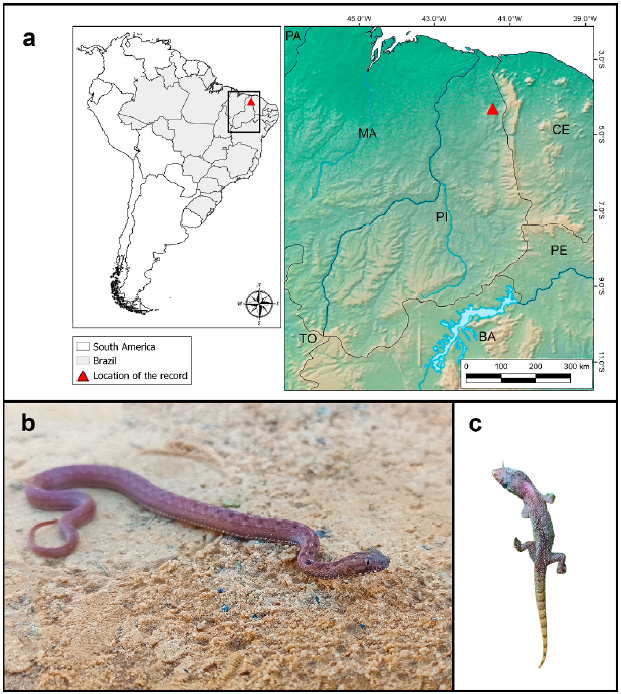Information on diet is of great importance to understand the interaction of species with their environment and with other coexisting species, besides to understand how the eating habits are related to ecological and phylogenetic factors (França et al., 2008; Bellini et al., 2015). Ecological studies with snakes are scarce due to their cryptic habits, which means that information about diet and trophic ecology is, in most cases, obtained from specimens deposited in scientific collections (Bernarde, 2012; Dias Silva et al., 2021) or through occasional records (Santana and Teixeira, 2020).
The genus Thamnodynastes Wagler, 1830 currently comprises 21 species of snakes widely distributed throughout South America, occurring in gallery forests, shrubs, and flooded savannas (Trevine et al., 2021; Uetz et al., 2022). Of these species, five occur exclusively in Brazil [T. almae Franco and Ferreira, 2003, T. longicaudus Franco, Ferreira, Marques and Sazima, 2003, T. phoenix Franco, Trevine, Montingelli and Zaher, 2017, T. rutilus (Prado, 1942), and T. sertanejo Bailey, Thomas and Da Silva, 2005] (Nogueira et al., 2019; Trevine et al., 2021). The genus has a complex taxonomy, still presenting one species with identification and distribution not yet well resolved (e.g., Thamnodynastes cf. nattereri) (Barbosa et al., 2020). Due to the overlapping characters, the diagnosis is often confusing, reflecting a large information gap on most of these species' taxonomic and ecological issues (Franco et al., 2017; Trevine et al., 2021). However, Thamnodynastes species present in general medium size, vertical pupils, single nasal scale, odd number dorsal scale, apical pits, and anal plate divided, in addition to nocturnal habits, viviparity and opistoglyphic dentition (Franco et al., 2017; Barbosa et al., 2020).
Herein, we reported the first record of Hemidactylus agriusVanzolini, 1978 in the diet of T. phoenix in northeastern Brazil. On 17 July 2021, at 9:30 h, during fieldwork, in the locality Serra dos Matões, municipality of Pedro II, state of Piauí, northeastern Brazil (4°19' S and 41°27' W, datum WGS84, 620 a. l. s.; Fig. 1a), we registered a young individual of T. phoenix (snout-vent length - SVL = 187.68 mm; weight = 5.18 g; Fig. 1b) on an access trail to the Urubu Rei waterfall, near the Mirante do Gritador. The snake was collected and properly transported in a plastic container and after a few minutes of capture, the individual regurgitated a lizard of the species H. agrius (SVL = 33.34 mm; weight = 1.18 g; Fig. 1c). The specimens were fixed and deposited in the Biological Collection of the Instituto Federal de Educação, Ciência e Tecnologia do Piauí - IFPI Campus Pedro II (T. phoenix CBPII 255, H. agrius CBPII 257).
Thamnodynastes phoenix is a typical snake of the northeastern Brazilian, widely distributed in the Caatinga biome, with records bordering the Cerrado biome, living in sympatry with at least two species: T. almae and T. sertanejo (Pergentino and Ribeiro, 2017; Nogueira et al., 2019). It is morphologically distinguished from its congeners by the presence of 19-19-15 dorsal scales, 133-159 ventral scales, and 40 to 66 subcaudals, with the ventral portion of the head extremely stained with dark brown spots and two pairs of noncontinuous longitudinal dark ventral stripes (Franco et al., 2017).
Hemidactylus agrius was initially described as endemic to the Caatinga (Vanzolini, 1978), having its geographic distribution extended to the Cerrado (Andrade et al., 2004). It has nocturnal and terrestrial habits (Mesquita et al., 2017), is generalist in the use of its microhabitat, and is generally found inactive under tree bark during the day (Passos et al., 2015). Hemidactylus agrius is morphologically like its congener H. mabouia (Moreau De Jonnès, 1818), an introduced species widely distributed in northeastern Brazil, but it is distinguished by the presence of ventral lamellae in the fourth toe that reach the base of the foot and by the presence of a greater number of tubercles on the dorsum and in the limbs, especially in the forearm (Vanzolini, 1978).
In general, T. phoenix is a poorly studied species and what is known about its diet is provided by sporadic records of predation, consisting mainly of anurans: Physalaemus cicada Bokermann, 1966, Rhinella granulosa (Spix, 1824), and Leptodactylus cf. macrosternum Miranda-Ribeiro, 1926 (Pergentino and Ribeiro, 2017); lizards: Tropidurus semitaeniatus (Spix, 1825) and H. agrius (Silva et al., 2018, present study); and one report of cannibalism (Morais et al., 2020). For T. phoenix there is only one record of a T. semitaeniatus found in the stomach of the snake after fixed (Silva et al., 2018). Thus, this is the second record of lizard in the diet of this species. Species of the Thamnodynastes genus have a generalist diet consisting of fish, frogs, lizards, lizard eggs, and rodents (Bernarde et al., 2000; Bellini et al., 2015; Bortolanza-Filho et al., 2019), although data on lizard predations are still scarce, representing less than 4% of the diet of the species (Bernarde et al., 2000; Bellini et al., 2015). However, most species of the genus occurring in Brazil still do not have data on their diet.
Studies on snake diet provide important information about natural history, contributing inclusive to the evolutionary biology and conservation of the species, that although it has increased, it is still quite fragmented and/or limited (Sawaya et al., 2008; Barbo et al., 2011). Our work reports the first record of a Gekkonidae predated by T. phoenix and only the fourth study on the food items of this species, thus expanding the knowledge about its food ecology.
















